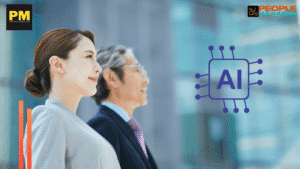Navigating AI Implementation: A Human-Centric Approach Required
People often fear losing their jobs due to AI, but the real threat lies in the disruption of professional identity,” Herbert said. “It’s about how AI will reshape roles and impact the very essence of how individuals identify themselves within their careers- Cecelia Herbert

The integration of artificial intelligence (AI) has become not just a trend, but a necessity for staying competitive in today’s rapidly evolving business landscape. While AI promises increased efficiency, productivity, and profitability, its implementation often triggers apprehension and resistance among employees, according to Cecelia Herbert, principal behavioural psychologist at Qualtrics.
“People often fear losing their jobs due to AI, but the real threat lies in the disruption of professional identity,” Herbert said. “It’s about how AI will reshape roles and impact the very essence of how individuals identify themselves within their careers.”
Integrating AI into the Workforce
When integrating AI technology and tools to increase efficiency, it is critical for employers to acknowledge the emotional component that comes with navigating AI adoption. Merely focusing on rational explanations regarding how AI will increase efficiency and productivity isn’t enough to alleviate employee fears that their jobs may be replaced by technology, Herbert said at Qualtrics’ X4 Summit in Salt Lake City.
For AI initiatives to succeed, she stresses the importance of involving employees in the process and recognizing that AI isn’t inherently good or bad—it’s how it’s used that matters.
“Bringing employees onboard with AI isn’t just a favour, it’s crucial for organizational success,” she said. “Employees need to see how AI will create space for high-value tasks, not just increase their workload.”
Successful AI implementation hinges on understanding and addressing the human element. By actively involving employees, aligning AI initiatives with organizational goals, and prioritizing human experiences, businesses can navigate the AI landscape with confidence and reap the benefits of technological advancement without sacrificing employee well-being, Herbert said.
Recommendations for Employers
When considering AI’s impact on HR functions, she encourages HR professionals to leverage existing skills and capabilities. Instead of starting with technology, she advises HR teams to begin with identifying areas for improvement and then seek AI solutions.
“HR’s transition from an administrative to a strategic function can be facilitated by embracing AI,” she said. “It’s about focusing on tasks that can be augmented by AI while retaining the human touch in areas like employee sentiment analysis. It’s important not to get overwhelmed by the technology; focus on what you’re trying to achieve because there’s an AI tool out there to support your goals, you just have to find the right fit.”
As organizations embark on their AI journey, it’s essential to recognize that AI implementation isn’t just a technological shift but a cultural transformation, creating a need for organizations to adopt a holistic approach that integrates AI seamlessly into existing workflows while fostering a culture of openness, transparency, and continuous learning, Herbert said.
“Employers are going to have skill and capability development for existing staff, so that they understand AI and how to use it because otherwise you run a risk in your organization of employees using these tools without understanding them,” she said. “Employers also need to consider that AI integration means a lot of jobs are going to change significantly, so that means redesigning jobs, sitting down and thinking about what the future of the workforce looks like.”
“We need to lose a lot of the traditional methods of job design, which was about tasks and move towards a skills-based approach in which we analyse the skills and capabilities that we’re going to need, so that there is a lot more internal mobility across organizations to help people move into or evolve their roles into that new future of work.”
Additional Insights
AI is not just about technology; it’s about people and processes. It’s about how we work, how we communicate, and how we make decisions. It’s about creating a culture of innovation and continuous learning, where employees are empowered to experiment, learn, and grow.
AI can be a powerful tool for enhancing decision-making, improving efficiency, and driving innovation. But it’s not a silver bullet. It requires a thoughtful, strategic approach, with a clear understanding of what AI can and cannot do, and a commitment to investing in the necessary infrastructure, training, and support.
AI is not a threat to jobs, but a tool that can enhance human capabilities and free up time for more strategic, creative, and high-value tasks. The key is to ensure that employees understand this and see AI as a tool that can help them do their jobs better, not as a threat to their job security.
In conclusion, the successful implementation of AI requires a human-centric approach, with a focus on understanding and addressing the human element, involving employees in the process, and aligning AI initiatives with organizational goals. By doing so, businesses can navigate the AI landscape with confidence and reap the benefits of technological advancement without sacrificing employee well-being.
Stay tuned, to PropleManager.co.in for further updates on the evolving workplace paradigm.
Value our content… contribute towards our growth. Even a small contribution per month would be of great help to us. Since our establishment, we have been serving the industry through daily news and updates.
Our content is free for all, and we plan to keep it that way
Support the People Manager. Pay Here
- 𝐕𝐢𝐫 𝐁𝐡𝐚𝐫𝐚𝐭 𝐓𝐚𝐤𝐞𝐬 𝐎𝐧 𝐭𝐡𝐞 𝐌𝐚𝐧𝐝𝐚𝐭𝐞 𝐨𝐟 𝐒𝐞𝐜𝐫𝐞𝐭𝐚𝐫𝐲, 𝐍𝐇𝐑𝐃𝐍 𝐃𝐞𝐥𝐡𝐢 & 𝐍𝐂𝐑 𝐂𝐡𝐚𝐩𝐭𝐞𝐫 𝐟𝐨𝐫 𝟐𝟎𝟐𝟓–𝟐𝟎𝟐7 - December 6, 2025
- Suvarna Nikam On How AI-First Campaigns are Reinventing Employee Experience? - November 28, 2025
- How Siemens India is redefining workforce transformation by embedding HR at the strategic core ? - October 28, 2025









